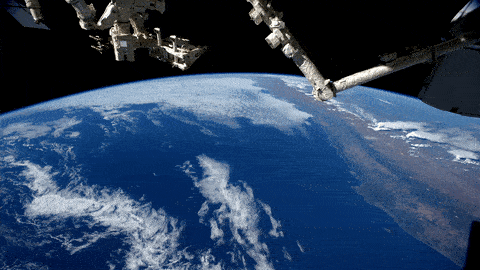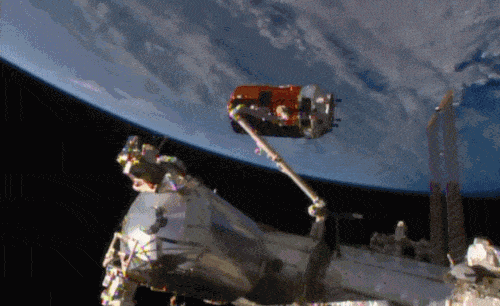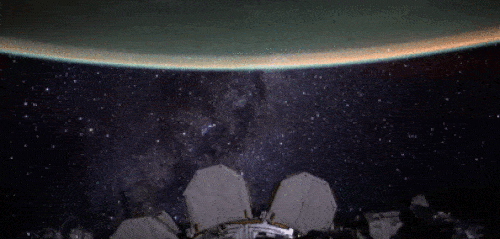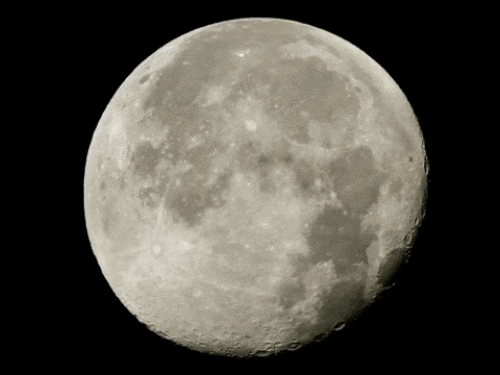Your gateway to endless inspiration
ISS - Blog Posts

Spacewalk complete and new astronaut record set! Shane Kimbrough and Peggy Whitson of NASA successfully reconnected cables and electrical connections on an adapter-3 that will provide the pressurized interface between the station and the second of two international docking adapters to be delivered to the complex to support the dockings of U.S. commercial crew spacecraft in the future. The duo were also tasked with installing four thermal protection shields on the Tranquility module of the International Space Station.
Having completed her eighth spacewalk, Whitson now holds the record for the most spacewalks and accumulated time spacewalking by a female astronaut. Spacewalkers have now spent a total of 1,243 hours and 42 minutes outside the station during 199 spacewalks in support of assembly and maintenance of the orbiting laboratory.
Astronaut Thomas Pesquet of ESA posted this image and wrote, ' Shane and Peggy on their way to their first #spacewalk tasks.'
Credit: ESA/NASA
Jeff Williams: Record Breaker
Astronaut becomes U.S. record holder for most cumulative time in space!
The Olympics are over, but Americans are STILL breaking records. NASA astronaut Jeff Williams just broke Scott Kelly’s record of 520 cumulative days spent in space. When Williams returns to Earth on Sept. 5, he will have racked up 534 days in space. To celebrate this amazing achievement, here are some of the best images taken during his four spaceflights.

STS-101 Atlantis:
During May 2000, Williams made his first spacewalk during space shuttle Atlantis’ STS-101 mission. On this 10-day mission, Williams’ first spacewalk lasted nearly seven hours. He is pictured here outside the space station.

Expedition 13:
Williams experienced his first long-duration mission in 2006, when he served as flight engineer for Expedition 13 space station mission. During his time in orbit, he performed two spacewalks, saw the arrival of two space shuttle missions and resumed construction of the orbiting laboratory during his six-month tour. While on one of those spacewalks, Williams took this selfie.

Expedition 21/22:
Williams returned to space for another six-month mission in 2009 as a flight engineer on Expedition 21 and commander of Expedition 22. During that time, he hosted the crews of two space shuttle missions. The U.S.-built Tranquility module and cupola were installed on station. Here is an image of the then newly installed cupola.

Expedition 47/48:
This time around, Williams has been onboard the space station since March 2016, where he served as flight engineer for Expedition 47 and now commands Expedition 48. With over 7,000 retweets on Williams’ photo of an aurora from space, his Twitter followers were clearly impressed with his photography skills.
Make sure to follow us on Tumblr for your regular dose of space: http://nasa.tumblr.com
Solar System: Life Among the Stars
Let us lead you on a journey of our solar system. Here are some things to know this week:
1. Amateur" Means "One Who Loves"

We release thousands of breathtaking solar system images every year and not all of them are the exclusive result of work by scientists. Amateur image processors around the world take raw data from deep space missions and turn it into striking visuals.
Amateur images from Cassini
Get current unprocessed images
2. Prepare to Weigh Anchor

OSIRIS-REx, our first spacecraft destined to rendezvous with, study and return a sample of an asteroid, will launch. The mission to asteroid Bennu will yield the largest sample returned from space since the Apollo era. Tune in four our media briefing about OSIRIS-REx for 2 p.m. EDT on Aug. 17.
Learn more and tune in.
3. Out for a Walk

Join us for live coverage on Aug. 19 as our astronauts Jeff Williams and Kate Rubins install a new gateway for American commercial crew spacecraft at the International Space Station.
Live coverage of the spacewalk.
4. The Weather Out There

Aug. 17 marks 50 years since the launch of Pioneer 7, a robotic spacecraft that lived up to its name by exploring the solar magnetic field, the solar wind and cosmic rays in deep space. Along with Pioneers 6, 8, and 9, the spacecraft formed a ring of solar weather stations spaced along Earth's orbit. Measurements by the craft were used to predict solar storms for organizations ranging from commercial airlines to power companies.
Learn more.
5. Destination: The Red Planet

The European Space Agency's ExoMars/Trace Gas Orbiter mission to Mars performed a critical engine burn to keep it on course. The maneuver was a success, and ExoMars remains on target for an October arrival.
Learn more.
Discover the full list of 10 things to know about our solar system this week HERE.
Make sure to follow us on Tumblr for your regular dose of space: http://nasa.tumblr.com
Space Station Research: Observing Earth
Each month, we highlight a different research topic on the International Space Station. In April, our focus is how the space station provides a platform for studying the Earth.

You might wonder how a laboratory 250 miles above Earth could help us study and observe our home planet, but the space station actually gives us a unique view of the blue marble we call home.
The space station is part of a fleet of Earth remote-sensing platforms to develop a scientific understanding of Earth’s systems and its response to natural or human-induced changes and to improve prediction of climate, weather and natural hazards. Unlike automated remote-sensing platforms, the space station has a human crew, a low-orbit altitude and orbital parameters that provide variable views and lighting. Crew members have the ability to collect unscheduled data of an unfolding event, like severe weather, using handheld digital cameras.

The Cupola, seen above, is one of the many ways astronauts aboard the space station are able to observe the Earth. This panoramic control tower allows crew members to view and guide operations outside the station, like the station’s robotic arm.

The space station also has an inclined, sun-asynchronous orbit, which means that it travels over 90% of the inhabited surface of the Earth, and allows for the station to pass over ground locations at different times of the day and night. This perspective is different and complimentary to other orbiting satellites.
The space station is also home to a few Earth-observing instruments, including:

The ISS-RapidScat monitors ocean winds for climate research, weather prediction and hurricane science. This vantage point gives scientists the first near-global direct observations of how ocean winds can vary over the course of the day, while adding extra eyes in the tropics and mid-latitudes to track the formation and movement of tropical cyclones.

CATS (Cloud-Aerosol Transport System) is a laser instrument that measures clouds and airborne particles such as pollution, mineral dust and smoke. Improving cloud data allows scientists to create more accurate climate models, which in turn, will improve air quality forecasts and health risk alerts.

In late 2016, we will launch Stratospheric Aerosol and Gas Experiment III (SAGE III). This experiment will measure ozone and other gases in the atmosphere to help scientists assess how the ozone layer is recovering.

Want to observe the Earth from a similar vantage point? You can thanks to our High Definition Earth-Viewing System (HDEV). This experiment is mounted on the exterior of the space station and includes several commercial HD video cameras aimed at the Earth.
Make sure to follow us on Tumblr for your regular dose of space: http://nasa.tumblr.com
How Do You Stay Fit on a Mission to Mars?
This mini exercise device could be the key!
Onboard the International Space Station, astronauts need to work out to maintain their bone density and muscle mass, usually exercising 2 hours every single day. Throughout the week, they exercise on three different pieces of equipment--a bike, a treadmill and the Advanced Restive Exercise Device (ARED).

All these devices are needed to keep an astronaut healthy.
However, deep-space vehicles like our Orion Spacecraft aren’t as roomy as station, so everything — including exercise equipment — needs to be downsized. The Miniature Exercise Device (MED-2) is getting us one step closer to being able to keep astronauts’ bodies healthy on long journeys to the moon, Mars and beyond.

MED-2 is a compact, all-in-one exercise device that we developed and will be launching to the space station Tuesday, March 22. Onboard the station, we’ll see how MED-2 will perform in microgravity and how it will need to be further adapted for our Journey to Mars. However, it’s already pretty well equipped for deep space missions.
So what makes MED-2 so great for deep space travel and our Journey to Mars?
1. It is an all-in-one exercise device, meaning it can do both aerobic and resistive workouts. When we go to Mars, the less equipment we need, the better.

2. It's incredibly light. The MED-2 weighs only 65 pounds, and every pound counts during space missions.

3. It has 5 - 350 pounds of resistance, despite weighing only 65 pounds. Astronauts don’t all lift the same amount, making the flexibility in MED-2’s “weights” essential.

4. It's tiny. (Hence its name Miniature Exercise Device.) Not only is MED-2 incredibly light, but it also won't take up a lot of space on any craft.

5. It powers itself. During an aerobic workout, the device charges, and then that power is used to run the resistive exercises. When traveling to space, it's good when nothing goes to waste, and now astronauts' workouts will help power the Journey to Mars.

MED-2 is only one of many devices and experiments flying on Orbital ATK’s Cygnus spacecraft. To find out more about the science on the space station, follow @ISS_Research and @Space_Station on Twitter.
Make sure to follow us on Tumblr for your regular dose of space: http://nasa.tumblr.com

Aboard the International Space Station this morning, Astronaut Kimiya Yui of the Japan Aerospace Exploration Agency (JAXA) successfully captured JAXA's Kounotori 5 H-II Transfer Vehicle (HTV-5) at 6:28 a.m. EDT.
Yui commanded the station's robotic arm, Canadarm2, to reach out and grapple the HTV-5, while NASA astronauts Kjell Lindgren provided assistance and Scott Kelly monitored HTV-5 systems. The HTV-5 launched aboard an H-IIB rocket at 7:50 a.m. Wednesday, Aug. 19, from the Tanegashima Space Center in southern Japan. Since then, the spacecraft has performed a series of engine burns to fine-tune its course for arrival at the station.
The HTV-5 is delivering more than 8,000 pounds of equipment, supplies and experiments in a pressurized cargo compartment. The unpressurized compartment will deliver the 1,400-pound CALorimetric Electron Telescope (CALET) investigation, an astrophysics mission that will search for signatures of dark matter and provide the highest energy direct measurements of the cosmic ray electron spectrum.
Below is a breathtaking image shared by Astronaut Scott Kelly of the HTV-5 and Canadarm2, which reached out and grappled the cargo spacecraft.

International Space Station

The International Space Station is an important and special place that is built on international cooperation and partnership. The station is a convergence of science, technology and human innovation that benefits and advances our global community here on Earth.

While the space station is an important aspect of our low-Earth orbit exploration, it is also the key to our next giant leap to deep space and our Journey to Mars. For example, our recent VEGGIE experiment aboard the space station is a critical aspect of long-duration exploration missions farther into the solar system. Food grown in space will be a resource for crew members that can provide them will essential vitamins and nutrients that will help enable deep space pioneering.
Another important experiment underway is the Twins Study that involves twin astronauts Scott and Mark Kelly. These investigations will provide insight into the subtle effects and changes that may occur in spaceflight as compared to Earth by studying two individuals who have the same genetics, but are in different environments for one year. You can follow Scott Kelly as he spends a year in space.

The space station is the second brightest object in the sky (after the moon, of course), and you don’t even need a telescope to see it! We can even tell you exactly when and where to look up to Spot the Station in your area!
So, as you look to spot the station in the sky, remember that even though it may look small from Earth, the crew onboard (and at home) are making contributions to international partnerships and global research.
NASA Astronaut Scott Kelly shared this incredible video tonight, August 11, showing "our galactic home" with the stars of the Milky Way. Kelly is living and working off the Earth, for the Earth aboard the station for a yearlong mission. Traveling the world more than 220 miles above the Earth, and at 17,500 mph, he circumnavigates the globe more than a dozen times a day conducting research about how the body adapts and changes to living in space for a long duration.
Video credit: NASA
That's one small bite for a man, one giant leaf for mankind: Today, astronauts Scott Kelly, Kjell Lindgren and Kimiya Yui of Japan sample the fruits of their labor after harvesting a crop of "Outredgeous" red romaine lettuce from the Veggie plant growth system on the International Space Station. They are the first people to eat food grown in space.
We’re maturing Veggie technology aboard the space station to provide future pioneers with a sustainable food supplement – a critical part of our Journey to Mars. As we move toward long-duration exploration missions farther into the solar system, Veggie will be a resource for crew food growth and consumption. It also could be used by astronauts for recreational gardening activities during deep space missions.
Why do we explore? Simply put, it is part of who we are, and it is something we have done throughout our history. In "We Are the Explorers," we take a look at that tradition of reaching for things just beyond our grasp and how it is helping us lay the foundation for our greatest journeys ahead. So what are we doing to enable exploration? We’re building the Orion spacecraft is built to take humans farther than they’ve ever gone before. Orion will serve as the exploration vehicle that will carry the crew to space, provide emergency abort capability, sustain the crew during the space travel, and provide safe re-entry from deep space return velocities. Orion will launch on NASA’s new heavy-lift rocket, the Space Launch System.
Also underway, is Astronaut Scott Kelly’s Year In Space. Kelly is living and working off the Earth, for the Earth aboard the station for a yearlong mission. Traveling the world more than 220 miles above the Earth, and at 17,500 mph, he circumnavigates the globe more than a dozen times a day conducting research about how the body adapts and changes to living in space for a long duration.